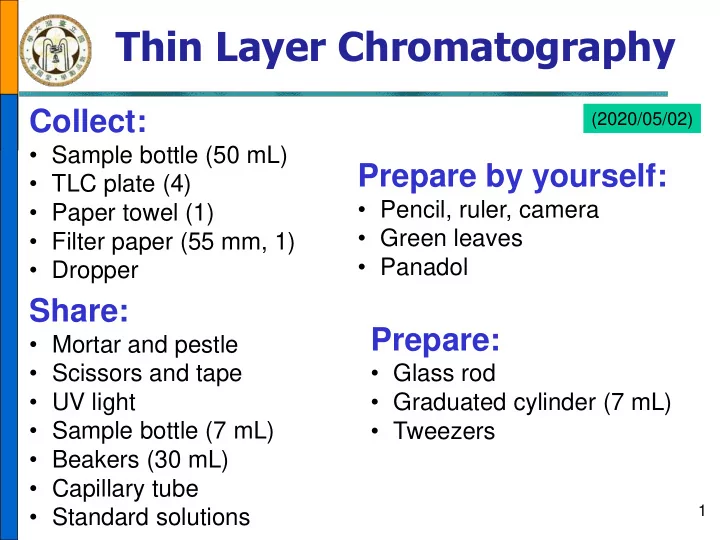

Thin Layer Chromatography Collect: (2020/05/02) • Sample bottle (50 mL) Prepare by yourself: • TLC plate (4) • Pencil, ruler, camera • Paper towel (1) • Green leaves • Filter paper (55 mm, 1) • Panadol • Dropper Share: Prepare: • Mortar and pestle • Scissors and tape • Glass rod • UV light • Graduated cylinder (7 mL) • Sample bottle (7 mL) • Tweezers • Beakers (30 mL) • Capillary tube • Standard solutions 1
Objective and Skills Objective: Using thin-layer chromatography (TLC) to separate and identify mixtures Pr Prin incipl ciple – Base on the distribution differences between the stationary phase and the mobile phase of compounds – Stationary phase: silica gel coated with fluorescent indicator F 254 – Mobile phase: • A solvent which causes all the spotted material to move with the solvent front is too polar. • One which will not cause any of the material in the spot to move is not polar enough. • Make an approximate judgment to choose the suitable solvent (may adjust by using EA and n -hexane) Sk Skil ill: l: Extraction, spotting, developing, visualization. 2
Flow Charts Part I: Thin layer chromatography of leaf extract Extract of green leaves Spotting on TLC plate Developing the plate Visualization Outline with pencil Calculate R f Part II: Thin layer chromatography of Panadol Dissolving samples Spotting on TLC plate Developing with two kinds of solvent Visualize under UV Outline with pencil Calculate R f 3 Extraction I. TLC of leaf extract II. TLC of Panadol
Step 1 Preparation of Leaf Extract Cut 5-6 pieces of dark green leaves Add 10 mL n -hexane/EA (4 : 1) as solvent and grind with mortar and pestle Extract to soln appears dark green May need more solvent for vaporization during grinding Conduct extraction in fume hood for organic vapor Use dropper to transfer leaf extract to 7- mL sample vial and label it Share the extract and capillary tube Compare the color and components 4 of different kinds of leaf extract
Step 2 Preparation of Panadol Take one tablet of Panadol; record the bran name and ingredients Grind to powder Weigh 0.05 g Panadol powder into 7 mL sample vial and add 5 mL EA to dissolve Standards prepared by stock room Acetaminophen standard Caffeine standard 5
Step 3 Prepare Development Chamber * Development solvent I. Leaf extract Solvent 1: n -hexane/acetone (7 : 3) II. Panadol 0.2 cm Solvent 1: n -hexane/acetone (7 : 3) Development chamber Solvent 2: EA/acetone (1 : 1) Cut a 55 mm filter paper to two pieces of rectangle shape Put the filter paper liner inside the 50 mL sample bottle Add suitable amount of solvent to moist the filter paper Adjust the solvent to a depth of 0.2-0.3 cm (about 2 mL) Cap the bottle and set aside to keep chamber saturated with 6 vapor
Step 4 Spotting the Plate * Sample plate I. Leaf extract plate • Three kinds of leaf extract II. Panadol sample plate 1) Acetaminophen standard 0.5 cm Draw the line and 2) Caffeine standard Three spots spotting lightly 3) Panadol test solution evenly spaced Place thin layer plate on a clean paper towel * Sample and capillary tube Lightly draw a line with pencil about 0.5 cm height from bottom Label three points on line separated from each other about 0.5 cm Dip capillary tube into test soln and be filled in • Sample with high concentration Touch lightly and briefly to the plate may cause tailing Keep spots small (ca. 2 mm) to get better 7 • Repeat spotting for dilute sample separation
Step 5 Developing TLC Plate Blow gently on the plate to evaporate the solvent and keep the applied spots small Place Hold it with tweezers by its edges and place it squarely squarely in the solvent surface. Do not touch the plate on the sides of bottle Filter Solvent level must not be above the spots, or paper liner the spotted material may dissolve in solvent Cap the bottle securely Solvent Note: Develop leaf extract plate with Solvent 1 n-hexane/acetone (7 : 3) Develop Panadol plate with previous Solvent 1: n -hexane/acetone (7 : 3) Discard Solvent 1 to waste bin and rinse with small portions of Solvent 2: EA/acetone (1 : 1) Replace filter paper liner and add suitable amount of Solvent 2: EA/acetone (1 : 1) to run another Panadol plate 8
Step 6 Visualization and Recording Line with pencil Take out TLC plate when solvent front runs near the edge Line the solvent front and circle the compounds with pencil * Panadol plate under UV light Visualize the colorless compounds under UV light with short wavelength (254 nm) R f = Height of compound Calculate the R f values of compounds Height of solvent front Compare the results among various leaf extract and developing system 9
Notice (condensed report) Conduct leaf extraction in fume hood for vaporization of organic solvent. Use dropper to transfer solvent with approximate amount. Share leaf extract, capillary tubes, and Panadol samples with each other. Be cautious about not mixing up the capillary tubes. Keep your TLC plate clean. Hold it with tweezers, place it on a paper towel, and avoid touching the silica gel by hands. Capillary tube can be used repeatedly. Rinse the tube by dipping it in clean solvent and withdrawn solvent out on paper towel several times. Shall the developed thin layer plate show edge effect, you may prepare another TLC plate and develop it again. Remain and tape your TLC plates on report to show your separation results and support your discussion. After class, recycle capillary tubes, organic solvent, and residue of leaf extract. 10
Recommend
More recommend